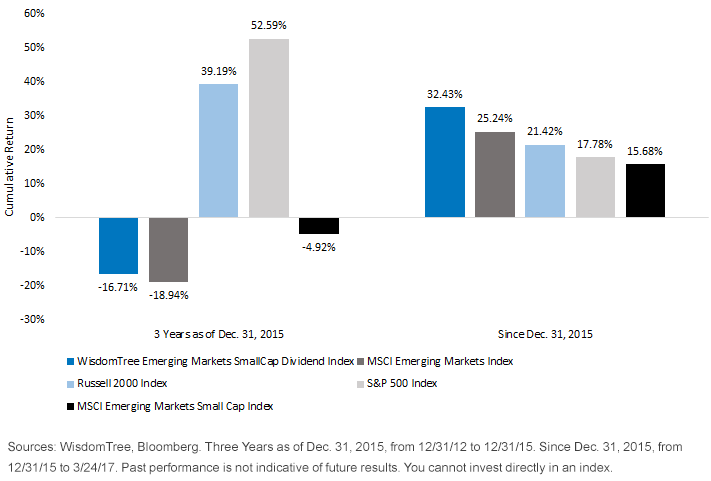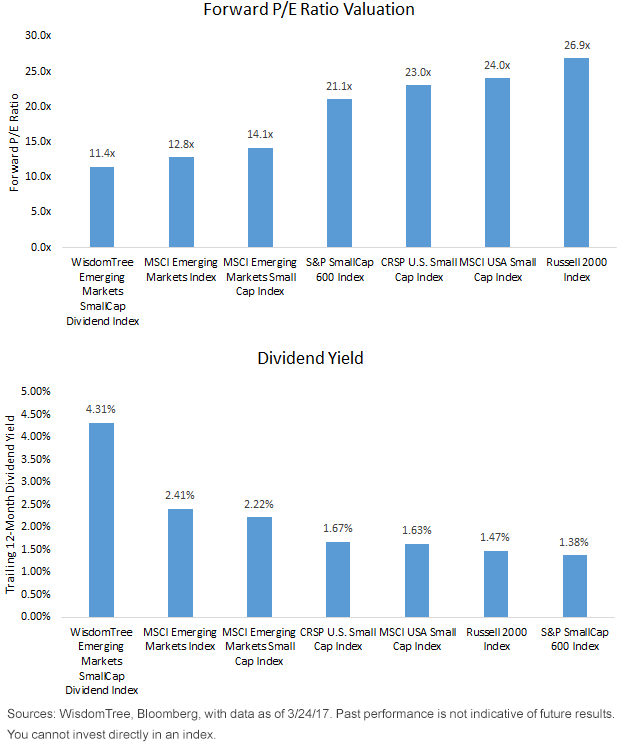How Emerging Markets Have Sneaked Back in Vogue


We remember speaking with clients in December 2015, and at that point:
- The price per barrel of West Texas Intermediate crude oil was between $30 and $40, trending downward.1
- The Bloomberg Dollar Spot Index was on its way to notching a 9% return for 2015, punctuated in part by a Brazilian real that would depreciate by nearly 33% versus the U.S. dollar.2
- The FTSE China 50 Index was on its way to delivering a return of -11.39% for 2015.3
Even if we could present compelling valuations compared to other global equity markets, there was simply too much carnage for many to see beyond. Also, after such drastic outperformance of U.S. equities, we remember hearing that many clients were no longer holding a position in emerging markets.
As has often been the case, the inflection point came when many were least expecting it.
After Three Years of Dramatic Underperformance, Emerging Markets Have Fired Back Up

For definitions of indexes in the chart, visit our glossary.
- Three Years as of December 31, 2015: We all know that was a very tough period for emerging markets. Looking at the MSCI Emerging Markets Index, the currency headwind—in other words, the U.S. dollar’s appreciation versus the collective emerging market currencies—of more than 21% canceled out any possibility of positive equity returns. Additionally, the S&P GSCI Index was down nearly 56% cumulatively over this period. There simply were not a lot of positive potential catalysts during that period.
- Since December 31, 2015: This period of emerging market equity outperformance sneaked up on many people. The U.S. Federal Reserve (Fed) had just moved the target for its Federal Funds Rate up,4 causing many to build a consensus view for a stronger U.S. dollar—a headwind for emerging market equities. Additionally, there were many questions 1) concerning how low the price of a barrel of oil could go, and 2) concerning the possibility of risks to China’s economic growth. Very few were itching to allocate to emerging markets, but what’s clear is that since then, the MSCI Emerging Markets Index has outperformed the S&P 500 Index.
What about Emerging Market Small Caps?
Even more interesting is the fact that the WisdomTree Emerging Markets SmallCap Dividend Index delivered nearly twice the return of the S&P 500 Index over this period and did even better than the MSCI Emerging Markets Index, as well as the MSCI Emerging Markets Small Cap Index, which underperformed the S&P 500 Index over the same period.
After 15 Months of Outperformance, Has the Window Closed?
Market participants—after any period of outperformance—will typically ask whether the opportunity was missed. Since the future is always uncertain, answering that question in an absolute sense is impossible, but we always come back to relative valuation comparisons.
We specifically ask—knowing that the WisdomTree Emerging Markets SmallCap Dividend Index just underwent a period of outperformance—has it now become expensive compared to U.S. small-cap indexes? If it hasn’t, we think there is 1) less of a chance that the opportunity was missed and 2) the potential for a diversifying effect if market participants forgo allocating the full percentage of their small-cap stocks to the U.S. and diversify some of that position in emerging markets.
WisdomTree Emerging Markets SmallCap Dividend Index Still Indicates Significant Valuation Advantage

- Small-Cap Stocks at a Forward Price-to-Earnings (P/E) Ratio below 12.0x: While this would clearly be difficult to find among the commonly followed U.S. small-cap equity indexes shown here (all of which trade over 21.0x), the WisdomTree Emerging Markets SmallCap Dividend Index offers such an opportunity. Again, this is after outperforming the Russell 2000 Index over the prior period of about 15 months.
- 771 Stocks & a Dividend Yield above 4.3%: Many might ask WisdomTree how it’s even possible to have an emerging market small-cap equity index comprised solely of dividend payers. As of March 24, 2017, there were 771 such stocks.5 That’s more than the 694 stocks in the WisdomTree SmallCap Dividend Index, which focuses on U.S. stocks.6 The real benefit: a dividend yield of more than 4.3%, more than twice the dividend yield of the commonly followed U.S. market capitalization-weighted indexes.
Looking Forward: Catalysts to Watch
Emerging market equities—like those in other markets—are all about the catalysts. First, the Fed has raised rates three times in the current tightening cycle, but the U.S. dollar has largely weakened in response, a positive outcome for emerging markets.7 Second, the price of oil has been tending to fall8 but a) isn’t pushing the February 2016 lows, and b) small-cap emerging markets largely avoid the massive state-run energy firms most impacted by the price of oil and other commodities. Third, and most importantly, small-cap emerging markets are really an access play on the emerging market consumer, as these companies derive the bulk of their revenue from inside their home markets. With the bulk of global population in emerging markets, many investors whom we speak with—even those nervous about emerging markets—recognize that the emerging market consumer will be an important force propelling global growth in the coming decades.
1Source: Bloomberg, with data as of 12/15.
2Source: Bloomberg, with data measured from 12/31/14 to 12/31/15.
3Source: Bloomberg, with data measured from 12/31/14 to 12/31/15.
4Source: Federal Reserve Open Market Committee Press Release, 12/16/15.
5Sources: WisdomTree, Standard & Poor’s.
6Sources: WisdomTree, Bloomberg.
7Source: Bloomberg, with performance of the U.S. dollar measured against major emerging market and developed market currencies from 12/31/16 to 3/24/17.
8Source: Bloomberg, noting behavior of West Texas Intermediate Crude Oil price-per-barrel in March of 2017 up to 3/24/2017.
Important Risks Related to this Article
Investments in emerging, offshore or frontier markets are generally less liquid and less efficient than investments in developed markets and are subject to additional risks, such as risks of adverse governmental regulation and intervention or political developments.Investments focusing on certain sectors and/or smaller companies increase their vulnerability to any single economic or regulatory development. This may result in greater share price volatility.

Christopher Gannatti began at WisdomTree as a Research Analyst in December 2010, working directly with Jeremy Schwartz, CFA®, Director of Research. In January of 2014, he was promoted to Associate Director of Research where he was responsible to lead different groups of analysts and strategists within the broader Research team at WisdomTree. In February of 2018, Christopher was promoted to Head of Research, Europe, where he was based out of WisdomTree’s London office and was responsible for the full WisdomTree research effort within the European market, as well as supporting the UCITs platform globally. In November 2021, Christopher was promoted to Global Head of Research, now responsible for numerous communications on investment strategy globally, particularly in the thematic equity space. Christopher came to WisdomTree from Lord Abbett, where he worked for four and a half years as a Regional Consultant. He received his MBA in Quantitative Finance, Accounting, and Economics from NYU’s Stern School of Business in 2010, and he received his bachelor’s degree from Colgate University in Economics in 2006. Christopher is a holder of the Chartered Financial Analyst Designation.

